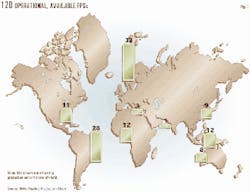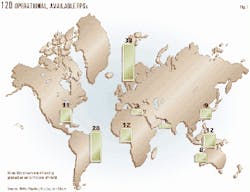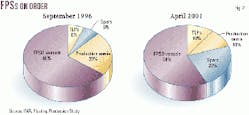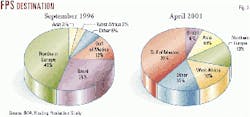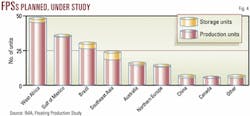Floating production systems installed in deepwater and remote locations have proven to be a major breakthrough in offshore oil and gas production.
This production technology has provided a solution to develop fields that otherwise would have been economically off limits to fixed platforms.
Floating production, which dates from the mid-1970s, is now being used on more than 120 offshore fields. About one quarter of the units are operating off Northern Europe, another quarter off Brazil, and the remainder are mostly in the Gulf of Mexico, off China-Southeast Asia, West Africa, and Australia (Fig. 1).
Floater comparison
There are four basic platform options for a floating production facility: ship-shape floating production, offloading (FPSO) vessels, tension leg platforms (TLPs), production semisubmersibles (FPSs), and spars. Each of these platform options has unique advantages and disadvantages that drive their popularity, and there are also differences in regional preferences.
Off West Africa, the most likely solution will be nonweathervaning FPSOs tied to subsea wells. Purpose-built units will be ordered for large fields such as Rosa, and converted hulls will see service in smaller fields. On very large fields, a spar or TLP will be considered as a production hub, but the local partner will likely push for the least cost up-front solution, which leans toward selecting FPSOs with subsea completion.
In the Gulf of Mexico, spars, mini-TLPs, or production semis will be the likely production solution on fields where they can be tied to the existing pipeline infrastructure. Operators in the Gulf like to minimize operational cost by installing surface trees, a capability of spars, making this production option attractive.
Weathervaning FPSO vessels will be a potential solution in the ultradeepwater central and western areas distant from pipeline infrastructure, with shuttle tankers delivering crude to the refineries along the Gulf Coast.
Off Brazil, Petroleos Brasileiro SA (Petrobras) will undoubtedly lean toward FPSOs (based on converted hulls) tied to subsea wellhead facilities in order to minimize capital expenditures. Existing production semisubmersibles will be moved around as fields are abandoned, but there will probably be no additional semis acquired, unless an opportune semi hull becomes available.
Oil majors operating off Brazil may be willing to incur the added capital expenditure for spars or TLPs that would enable them to have surface trees for minimizing well maintenance costs.
FPSO vessels, mostly weathervaning, will be the likely solution off China, Southeast Asia, and Australia. Purpose-built units will be selected for large fields with long life expectancy, particularly off China and Australia. Hulls for off China will likely be built locally. Converted hulls will be more likely to be used off Southeast Asia.
North Sea production units will be mostly weathervaning FPSO vessels with some purpose-built and some based on converted hulls. TLPs or spars are also possible on larger fields. Units now on station will be moved around.
FPSOs probably have the greatest flexibility of all production systems for deepwater fields. They have no weight constraints and can accommodate large processing units on their deck. Units equipped with internal turrets can operate in severe weather and sea conditions. Storage capability is built into the design of the vessels.
The main disadvantage of a turret-fitted FPSO is the limited number of risers that can be accommodated through the turret, which in turn restricts the number of wells that can be produced to the unit. FPSO vessels are the most popular platform for floating production systems. Almost 60% of the floating production systems now on order have ship-shape hulls.
Full size TLPs are particularly useful on large complex fields with high production throughput. They have the advantage of being able to utilize surface wellheads, which reduces the cost of well maintenance over the life of the field. TLPs have been popular in the Gulf of Mexico, where 11 units are in operation or on order. Included in this figure are seven full size TLPs and four mini-TLPs.
A major disadvantage of TLPs is tendon weight, which on a full-size unit more than doubles from 4,000 to 6,000-ft water depth and quadruples between 6,000 and 10,000-ft. water depth.
Production semis have no inherent water depth restriction, provide good motion characteristics, and can accommodate a large number of risers. Weight limitations ultimately constrain processing capability that can be placed on the unit.
Production semis had been the unit of choice in Brazil for many years, utilizing secondhand drilling rigs as platforms for conversion to production facilities. There are now 19 production semis operating off Brazil, 1 less than the 20 before the P-36 unit on the Roncador field sank. Recently, 2 large purpose-built production semis have been ordered for fields in the Gulf of Mexico.
Production spars have the advantage of accommodating production trees on the platform deck, a very important advantage in regions with high-paraffin oil that requires frequent well intervention. Spars also can accommodate storage, though none of the units now in operation do so. They also have good motion characteristics.
Spars have become extremely popular in the Gulf of Mexico, where there are 10 spars in operation or on order.
Recent orders
The past half year has seen a burst of orders for new floating production systems, reflecting upbeat conditions in the oil and gas sector. Between September 2000 and April 2001, 12 floating production units have been ordered: This includes 6 FPSOs, 4 production spars, and 2 production semis.
Among the orders is the Crazy Horse production semi, which will be the largest steel production semi built to date. With these new orders, 31 floating production systems are now being fabricated, which when installed will add 26% to the inventory of floaters in operation (Fig. 2).
A noticeable shift has taken place in the type of production system being built vs. 5 years ago. In 1996, about one quarter of the production units on order used semisubmersible hulls. Now spars comprise about one quarter of the production units being built, and only 10% of the 31 units currently on order are semisubmersibles.
Accounting for this shift in platform type is the growing popularity of spars as dry-tree completion units and the lack of suitable semisubmersible hulls available for conversion to production facilities.
The regions where floating production systems are to be used are also different. Almost half of the units under construction in 1996 were being built for fields in the North Sea, and another 30% of the units were being built for use off Brazil. Now the major destination is the Gulf of Mexico, which accounts for almost 40% of the systems currently on order.
Equally significant is the increased presence of West Africa as a destination for floating production systems. There are now more systems on order for use on fields off West Africa than for use in the North Sea (Fig. 3).
Planned new floaters
The International Maritime Associates Inc. (IMA) has identified 155 offshore projects in the bidding, design, or planning stage where a floating production or storage system is being considered as a development solution. Projects off West Africa account for 26% of these planned projects and the Gulf of Mexico accounts for another 22%.
There has been a significant drop in number of projects planned in the North Sea vs. 5 years ago, reflecting the downturn in new activity off Northern Europe (Fig. 4).
Particularly interesting is the large number of projects that have moved from the planning to final design and bidding stage since the second half of 2000. Close to 20 projects have their final design or bidding underway. This indicates a significant flow of orders for new floating production systems can be expected over the next 6-12 months.
Declining cost
Tremendous gains have been made in reducing the cost of floating production systems. According to Shell International Exploration & Development Inc., the unit cost of newly designed floating production systems has declined significantly since the Auger TLP was installed in the early 1990s. Shell expects its most recent unit being built, the Na Kika production semi for the Gulf of Mexico, will cost 50% of Auger, and by 2003 Shell expects new floating production systems to have a unit cost half that of Na Kika (Fig. 5).
The cost of Na Kika provides a good cost benchmark for fields in ultradeepwater. The field is in 6,000-ft water and is expected to recovery ultimately more than 300 million boe. The production semisubmersible being constructed for producing this field will have a capability to process and export 100,000 b/d oil and 325 MMcfd of gas.
Eventually, Shell plans to produced oil and gas from 10 satellite subsea wells. With present recoverable reserves estimates, Na Kika will have a producing life of about 8 years.
The development cost of Na Kika is as follows:
- $650 million for fabrication and installation of host facility and pipeline.
- $325 million for fabrication and installation of subsea components.
- $325 million for drilling and completion of wells.
- $135 million present value of annual operating cost.
- $1,435 million total life-of-field cost.
- $4.80/boe net present value (NPV) cost.
Shell projects total capital expenditures to develop Na Kika at $1.26 billion, excluding lease cost. About 50% of this cost is associated with fabricating and installing the host facility and pipeline, 25% with fabricating and installing subsea components, and 25% with drilling and completing the wells.
Shell estimates annual operating costs on Na Kika at about $25 million. Discounted back at 10%, present value of this cost would be $135 million. Adding this to capital expenditures, total life-of-field NPV cost to develop and produce Na Kika is about $1.4 billion.
Dividing this cost by 300 million boe results in a finding, lifting, and processing NPV cost of just under $4.80/boe.
Transport challenge
Pipelines have been the sole means of transporting oil produced on fields in the Gulf of Mexico and field operators in the Gulf have become very comfortable using pipeline for transport. But a number of fields in the ultradeepwater sector of the Gulf of Mexico are remote from the existing pipeline infrastructure, creating a requirement to look at shuttle tankers for transporting oil.
In a recent study, IMA has identified 165 potential development sites in the Gulf of Mexico in water depth greater than 5,000 ft. These are high-priority sites that are likely to be explored and potentially developed with floating production systems over the next 10 years.
These locations have flow assurance challenges because of the ultradeepwater that will likely require expensive technical solutions. More than half of these sites have very rugged seabed conditions that make pipeline installation difficult (Fig. 6).
This translates to higher pipeline capital and operating expenditures.
The decision between installing a pipeline from the floating production unit on the field vs. using a shuttle tanker for export will ultimately come down to the economics of the two options.
Pipeline cost will be influenced by the distance to the nearest infrastructure where a pipeline connection can be made, the seabed conditions in the surrounding area. and the volume discount on the connecting pipeline tariff that can be negotiated.
Shuttle tanker cost will be influenced by construction capital expenditure, which will likely be about $100-120 million, operating costs, and the need for excess capacity to ensure offtake capability under any weather conditions.
While conditions unique to each field will determine the outcome of this comparison, IMA has found 25-30 miles to be the approximate breakeven distance from infrastructure where a shuttle tanker becomes the low cost option. But introducing shuttle tanker transport into the Gulf of Mexico will meet lots of resistance, given the level of comfort everyone has with pipeline transport and the domestic sourcing requirements that mandate shuttle tankers in the Gulf of Mexico be built in the US.
The author
James R. McCaul is president of International Maritime Associates Inc., a management consulting firm based in the US that specializes in strategic planning and market analysis in the offshore and maritime sectors. He established IMA in 1973. Prior to forming IMA, he was member of the faculty of Webb Institute of Naval Architecture. McCaul has a PhD in economics from the University of Maryland, an MS in business administration from Pennsylvania State University, and a BS in marine science from the State University of New York. He is a member of NOIA, the American Economic Association, and Society of Naval Architects & Marine Engineers.
